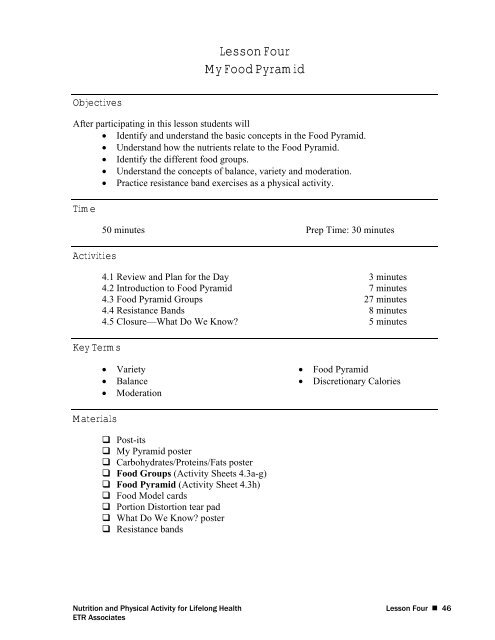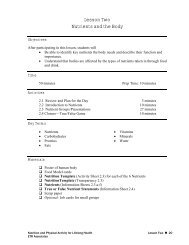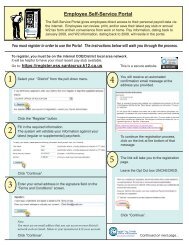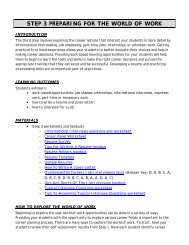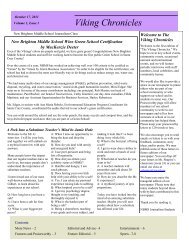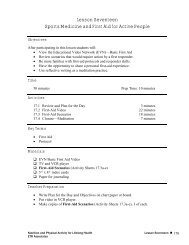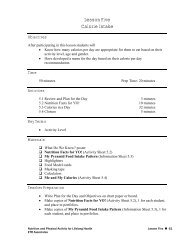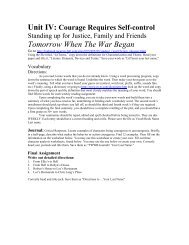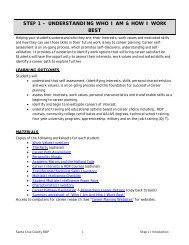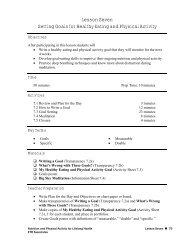Lesson 4 - Physical Education for Body, Mind and Spirit
Lesson 4 - Physical Education for Body, Mind and Spirit
Lesson 4 - Physical Education for Body, Mind and Spirit
You also want an ePaper? Increase the reach of your titles
YUMPU automatically turns print PDFs into web optimized ePapers that Google loves.
<strong>Lesson</strong> Four<br />
My Food Pyramid<br />
Objectives<br />
After participating in this lesson students will<br />
• Identify <strong>and</strong> underst<strong>and</strong> the basic concepts in the Food Pyramid.<br />
• Underst<strong>and</strong> how the nutrients relate to the Food Pyramid.<br />
• Identify the different food groups.<br />
• Underst<strong>and</strong> the concepts of balance, variety <strong>and</strong> moderation.<br />
• Practice resistance b<strong>and</strong> exercises as a physical activity.<br />
Time<br />
Activities<br />
Key Terms<br />
50 minutes Prep Time: 30 minutes<br />
4.1 Review <strong>and</strong> Plan <strong>for</strong> the Day 3 minutes<br />
4.2 Introduction to Food Pyramid 7 minutes<br />
4.3 Food Pyramid Groups 27 minutes<br />
4.4 Resistance B<strong>and</strong>s 8 minutes<br />
4.5 Closure—What Do We Know? 5 minutes<br />
• Variety<br />
• Balance<br />
• Moderation<br />
• Food Pyramid<br />
• Discretionary Calories<br />
Materials<br />
Post-its<br />
My Pyramid poster<br />
Carbohydrates/Proteins/Fats poster<br />
Food Groups (Activity Sheets 4.3a-g)<br />
Food Pyramid (Activity Sheet 4.3h)<br />
Food Model cards<br />
Portion Distortion tear pad<br />
What Do We Know? poster<br />
Resistance b<strong>and</strong>s<br />
Nutrition <strong>and</strong> <strong>Physical</strong> Activity <strong>for</strong> Lifelong Health <strong>Lesson</strong> Four • 46<br />
ETR Associates
Teacher Preparation<br />
• Order Portion Distortion tear pad <strong>and</strong> My Pyramid poster.<br />
• Write Plan <strong>for</strong> the Day <strong>and</strong> Objectives on chart paper or board.<br />
• Draw 3 columns on the board labeled Carbohydrates, Proteins, Fats.<br />
• Make Carbohydrates/Proteins/Fats poster that lines up with the My Pyramid poster.<br />
(See diagram in Activity 4.2.)<br />
• Make copies of Food Groups (Activity Sheets 4.3a-g), <strong>for</strong> each Food Pyramid group.<br />
• Make copies of Food Pyramid (Activity Sheet 4.3h), 1 <strong>for</strong> each student.<br />
• Create food group/physical activity posters on chart paper, 1 <strong>for</strong> each part of the Food<br />
Pyramid. (See Activity 4.3 <strong>for</strong> the questions to write on each poster.)<br />
• Create What Do We Know? poster on chart paper. (See Activity 4.5.)<br />
• Write 3 resistance b<strong>and</strong> exercises on dry erase/chalkboard or chart paper.<br />
4.1 Review <strong>and</strong> Plan <strong>for</strong> the Day 3 minutes<br />
Materials: Plan <strong>for</strong> the Day <strong>and</strong> Objectives<br />
Write the Plan <strong>for</strong> the Day <strong>and</strong> Objectives on the board be<strong>for</strong>e class, listing all of the<br />
activities students will be doing.<br />
Plan <strong>for</strong> the Day:<br />
• Introduction to Food Pyramid<br />
• Food Pyramid Groups<br />
• Resistance B<strong>and</strong>s<br />
• Closure—What Do We Know?<br />
Review the previous class by asking students what types of in<strong>for</strong>mation we can get from the<br />
Food Label.<br />
Explain that today they will be learning about the USDA (United States Department of<br />
Agriculture) Food Pyramid. They will be learning about the different in<strong>for</strong>mation that the<br />
Food Pyramid provides. Then they will be looking back on what they’ve learned in this class<br />
thus far. Class will end with some resistance b<strong>and</strong> exercises.<br />
Review the Objectives with students.<br />
4.2 Introduction to Food Pyramid 7 minutes<br />
Materials: My Pyramid Poster, Post-its, Carbohydrates/Proteins/Fats poster, dry<br />
erase/chalkboard<br />
Point out the three columns on the board labeled Carbohydrates, Proteins <strong>and</strong> Fats. Start by<br />
asking students to give you examples of foods in which the main nutrient is carbohydrates.<br />
Repeat the question <strong>for</strong> proteins <strong>and</strong> <strong>for</strong> fats. When students give their responses write the<br />
name of the food <strong>and</strong> Carbohydrate, Protein or Fat on a Post-it <strong>and</strong> place it under the<br />
Nutrition <strong>and</strong> <strong>Physical</strong> Activity <strong>for</strong> Lifelong Health <strong>Lesson</strong> Four • 47<br />
ETR Associates
appropriate column. After they give a few examples <strong>for</strong> each nutrient, show them the My<br />
Pyramid poster.<br />
• Give students a few moments to familiarize themselves with the My Pyramid poster.<br />
Then, ask where the food items they listed would go on the Food Pyramid. Give an<br />
example first, by taking one of the post-its <strong>and</strong> placing it on the food group slice<br />
where it belongs. For example, if the Post-it says “tortilla/carbohydrate” stick it on<br />
the Grains food group slice.<br />
• Once all of the post-its are on the poster, ask the students where carbohydrates fall on<br />
the pyramid. Make the point that grains, vegetables <strong>and</strong> fruits are our main sources of<br />
carbohydrates. Repeat the question <strong>for</strong> proteins <strong>and</strong> fats. Make the point that Meat<br />
<strong>and</strong> Beans are our main sources <strong>for</strong> protein, <strong>and</strong> Dairy <strong>and</strong> Oils are our main sources<br />
<strong>for</strong> fats.<br />
• Place the Carbohydrates/Proteins/Fats poster under the My Pyramid poster, line it up<br />
with the Pyramid as follows: Carbohydrates underneath the Grains, Vegetables <strong>and</strong><br />
Fruits, Proteins <strong>and</strong> Fats underneath the Meats <strong>and</strong> Dairy <strong>and</strong> Minerals <strong>and</strong> Vitamins<br />
under all food groups. (See the diagram below.)<br />
Carbohydrates Proteins Fats<br />
Minerals <strong>and</strong> Vitamins<br />
• Tell students that it’s important to balance (consume foods from all food groups on<br />
the Food Pyramid) their diet between all of the food groups. Write the word<br />
“balance” on the dry erase/chalkboard.<br />
• Direct students’ attention to the physical activity component of the Pyramid. Explain<br />
that this is a new addition to the Pyramid. Equally as important as having a healthy<br />
diet is making physical activity a regular part of each day.<br />
4.3 Food Pyramid Groups 27 minutes<br />
Materials: Food group/physical activity posters, Food Model cards, Food Groups (Activity<br />
Sheets 4.3a-g), Food Pyramid (Activity Sheet 4.3h), Portion Distortion tear pad (1 tear sheet<br />
per student)<br />
Explain that students will now be learning about the Food Pyramid (a graphic representation<br />
of human nutritional needs in the <strong>for</strong>m of a pyramid) by investigating one of the food groups<br />
or the physical activity component. There will be specific in<strong>for</strong>mation they will be asked to<br />
contribute to the class.<br />
Nutrition <strong>and</strong> <strong>Physical</strong> Activity <strong>for</strong> Lifelong Health <strong>Lesson</strong> Four • 48<br />
ETR Associates
• Explain that they will be working in groups. There will be 7 groups because there are<br />
7 parts to the Food Pyramid. Tell the students that they will be broken up into groups<br />
after they receive the in<strong>for</strong>mation on what they are to do.<br />
• Show students the Food Groups activity sheets. Explain that each group will receive<br />
one of these sheets. The activity sheet is specific to their food group. They are to fill<br />
it out using the in<strong>for</strong>mation provided on the top of the page.<br />
• Explain that once they are finished with the activity sheet they are going to transfer<br />
the in<strong>for</strong>mation to the poster <strong>for</strong> their food group.<br />
• Direct their attention to the chart paper posters around the room. Tell them that they<br />
are to find the poster that has their food group or physical activity on it <strong>and</strong> record<br />
their answers on it. (Prepare the chart paper be<strong>for</strong>e class with the questions they are to<br />
answer. See below.)<br />
• Questions <strong>for</strong> the 4 posters on Grains, Vegetables, Fruits <strong>and</strong> Milk groups:<br />
• 1 cup/ounce of “food group” is equal to: (students list 4 examples)<br />
• Daily Amount of “food group” <strong>for</strong> 2,000 calorie diet: ___________<br />
• Benefits of eating foods from this food group: (students list 2 benefits)<br />
• Questions <strong>for</strong> the Oils group:<br />
• Amount of Oil in Common Foods: (students list 2 examples)<br />
• Daily Amount of oil <strong>for</strong> 2,000 calorie diet:____________<br />
• Discretionary calorie allowance <strong>for</strong> 2,000 calorie diet:_____<br />
• Types of food that are discretionary: (students list examples)<br />
• Questions <strong>for</strong> the Meat <strong>and</strong> Beans group:<br />
• Common sizes of Meat <strong>and</strong> Bean portions: (students list 4 examples)<br />
• Daily Amount of Meat/Beans <strong>for</strong> 2,000 calorie diet:_______<br />
• Two ways to eat healthy from this food group: (students list 2<br />
examples)<br />
• Questions <strong>for</strong> the <strong>Physical</strong> Activity group:<br />
• <strong>Physical</strong> Activity should add up to at least ______ minutes/day<br />
• <strong>Physical</strong> Activity should be moderate to vigorous. (students list 3<br />
examples of moderate <strong>and</strong> vigorous activities)<br />
• Benefits of <strong>Physical</strong> Activity: (students list examples)<br />
• Give groups access to the Food Model cards, <strong>and</strong> allow enough time <strong>for</strong> them to fill<br />
out the Food Groups activity sheets <strong>and</strong> to complete transferring the in<strong>for</strong>mation to<br />
the food group posters.<br />
• Once all of the in<strong>for</strong>mation is added to the food group posters, have students return to<br />
their seats. Give each student a copy of the Food Pyramid activity sheet <strong>and</strong> ask<br />
them to fill it out using the answers on the food group posters they just completed.<br />
The intention is <strong>for</strong> students to get a big picture of how much <strong>and</strong> what kind of food<br />
should be consumed in a day in regards to the USDA Food Pyramid.<br />
• After students have filled out the Food Pyramid activity sheet, tell them that this is<br />
all the food they should eat in a day if they have a 2,000 calorie diet. Reiterate the<br />
word “balance,” stating that it’s important to get foods from all of the food groups.<br />
Nutrition <strong>and</strong> <strong>Physical</strong> Activity <strong>for</strong> Lifelong Health <strong>Lesson</strong> Four • 49<br />
ETR Associates
• Explain that there are two other words to learn. One is variety (eat different foods<br />
within each food group). Draw their attention to the Grains food group poster <strong>and</strong><br />
show them that it is important to eat several different types of grains within the food<br />
group. Write “variety” under “balance.”<br />
• Finally, tell the students it’s important to eat foods in moderation (consuming foods<br />
within reasonable limits, not excessive eating). Using the Grains food group poster,<br />
direct their attention to the Daily Amount box <strong>and</strong> tell them it’s important to eat the<br />
amount in the box in a day, but not more. Write the word “moderation” under<br />
“variety.”<br />
• H<strong>and</strong> out a Portion Distortion tear pad sheet to each student. Review it <strong>and</strong> answer<br />
any questions they may have. Show the “Measure up” section so they can see<br />
portion sizes. Tell them they can keep these <strong>for</strong>ms to use in the future.<br />
• Finish this activity by emphasizing the three words: balance, variety <strong>and</strong> moderation.<br />
They are key parts to following the Food Pyramid.<br />
4.4 Resistance B<strong>and</strong> Exercises 8 minutes<br />
Materials: Resistance B<strong>and</strong>s<br />
Explain that class will end with resistance b<strong>and</strong> exercises.<br />
• Remind students that resistance b<strong>and</strong>s develop muscular strength/endurance <strong>and</strong><br />
flexibility. They can determine the intensity of the exercise by grabbing the<br />
resistance b<strong>and</strong> closer to the center of the b<strong>and</strong>.<br />
• Show the resistance b<strong>and</strong> <strong>and</strong> demonstrate how to use it. Let students know that it is<br />
not <strong>for</strong> playing with, only <strong>for</strong> doing the specific exercises. Emphasize being safe<br />
while doing the exercises, so they won’t hurt themselves. It’s possible to injure a<br />
muscle by doing the exercises incorrectly. Show students the Resistance B<strong>and</strong><br />
Workout (Activity Sheet 1.1) in their portfolios to follow along with.<br />
• Explain that when choosing a b<strong>and</strong>, the thicker the b<strong>and</strong> the more resistance it has.<br />
Per<strong>for</strong>m the Resistance B<strong>and</strong> Workout with students. Have them find a space away from<br />
each other facing toward you. Demonstrate each exercise <strong>and</strong> then go around <strong>and</strong> help<br />
students with the individual exercises, as needed. Be<strong>for</strong>e class, choose 3 of the exercises to<br />
do <strong>and</strong> have them written on a piece of chart paper or the board.<br />
Nutrition <strong>and</strong> <strong>Physical</strong> Activity <strong>for</strong> Lifelong Health <strong>Lesson</strong> Four • 50<br />
ETR Associates
Exercises:<br />
• Bent Over Row<br />
Center tube under feet <strong>and</strong> bend <strong>for</strong>ward at the waist, back flat <strong>and</strong> abs in. Grab tube<br />
close to the feet <strong>and</strong> bend the elbows to pull the arms up to the torso, squeezing the<br />
back.<br />
• Overhead Press<br />
Place both feet on tube <strong>and</strong> grasp ends or h<strong>and</strong>les, bringing h<strong>and</strong>s up just over<br />
shoulders with elbows bent <strong>and</strong> palms in. Press arms up over head <strong>and</strong> then lower.<br />
• One-Armed Reverse Fly<br />
With front foot st<strong>and</strong>ing on one end of the b<strong>and</strong>, hold other end in one h<strong>and</strong> <strong>and</strong> lean<br />
over, abs in, torso at 45 degrees. Keeping elbow slightly bent <strong>and</strong> in a fixed position,<br />
raise arm out to shoulder level, squeezing shoulder blades.<br />
• One-Armed Lateral Raise<br />
St<strong>and</strong> with one end of tube under foot <strong>and</strong> the other end in one h<strong>and</strong>. Keeping elbow<br />
slightly bent <strong>and</strong> fixed, lift arm out to the side, to shoulder level.<br />
• Bicep Curl<br />
Place both feet on tube <strong>and</strong> grasp h<strong>and</strong>les (the wider the feet, the harder the exercise).<br />
Bend the elbows <strong>and</strong> curl h<strong>and</strong>s up toward shoulder. Lower <strong>and</strong> repeat.<br />
• Cross-<strong>Body</strong> Bicep<br />
Place left foot on b<strong>and</strong> <strong>and</strong> hold the h<strong>and</strong>le or end in right h<strong>and</strong>. Begin the move with<br />
palm facing in <strong>and</strong> bend the elbow, curling h<strong>and</strong> up towards the shoulder, going<br />
across the body.<br />
4.5 Closure — What Do We Know? 5 minutes<br />
Create a poster be<strong>for</strong>e class titled “What Do We Know?” Underneath the title write the<br />
following points:<br />
• Eat foods from all food groups.<br />
• Eat a variety of foods from each food group to get all the nutrients.<br />
• Monitor the size of a portion of food.<br />
Review the poster with students, covering the 3 points they’ve learned.<br />
Make the comparison to the Food Pyramid concepts of balance, variety <strong>and</strong> moderation.<br />
State that in the next class they will figure out how much to eat from each food group <strong>and</strong><br />
how much they should eat in a day, in terms of calories. Have students share one thing they<br />
learned today about the Food Pyramid.<br />
Nutrition <strong>and</strong> <strong>Physical</strong> Activity <strong>for</strong> Lifelong Health <strong>Lesson</strong> Four • 51<br />
ETR Associates
Resources<br />
Portion Distortion tear pad<br />
www.ncescatalog.com<br />
Product code: 3700<br />
My Pyramid large poster<br />
www.enasco.com<br />
Product code: WA24221H<br />
www.mypyramid.gov<br />
www.exercise.about.com<br />
Nutrition <strong>and</strong> <strong>Physical</strong> Activity <strong>for</strong> Lifelong Health <strong>Lesson</strong> Four • 52<br />
ETR Associates
Activity Sheet 4.3a<br />
Grains Food Group<br />
Make half your grains whole.<br />
1 ounce of grains is equal to:<br />
1 slice of bread<br />
1 cup of ready-to-eat cereal<br />
½ cup of cooked rice, cooked pasta or cooked cereal<br />
1 mini bagel<br />
3 cups popcorn<br />
1 small flour tortilla<br />
Daily Amount of Grains <strong>for</strong> 2,000 calorie diet:<br />
6 ounces<br />
Benefits of eating Grains:<br />
Eating grains provides lasting energy.<br />
Eating at least 3 ounce equivalents a day of whole grains may help with weight management.<br />
Eating grains <strong>for</strong>tified with folate be<strong>for</strong>e <strong>and</strong> during pregnancy helps prevent neural tube defects<br />
during fetal development.<br />
1 ounce of grains is equal to:<br />
1.) ____________ 3.)____________<br />
2.) ____________ 4.)____________<br />
Using the Food Model cards, select a combination of<br />
food items that will fulfill a daily amount <strong>for</strong> a person<br />
consuming 2,000 calories a day.<br />
_____________________________________<br />
What are 2 benefits of eating foods from this food<br />
group?<br />
1. __________________________________<br />
2. __________________________________<br />
U.S. Department of Agriculture<br />
Nutrition <strong>and</strong> <strong>Physical</strong> Activity <strong>for</strong> Lifelong Health <strong>Lesson</strong> Four • 53<br />
ETR Associates
Activity Sheet 4.3b<br />
1 cup of vegetables is equal to:<br />
Vegetables Food Group<br />
Vary your veggies.<br />
Dark-Green Vegetables:<br />
1 cup chopped broccoli<br />
1 cup cooked spinach<br />
2 cups raw leafy green lettuce<br />
Orange Vegetables:<br />
1 cup raw or cooked carrots<br />
1 large baked sweet potato<br />
Dry Beans <strong>and</strong> Peas:<br />
1 cup tofu<br />
1 cup cooked beans<br />
Starchy vegetables:<br />
1 large ear of corn<br />
1 medium baked potato<br />
Benefits of eating Vegetables:<br />
More energy<br />
Less likely to get colds <strong>and</strong> flu<br />
Healthier skin/clearer skin<br />
Healthy weight<br />
Daily Amount of Vegetables <strong>for</strong> 2,000 calorie diet:<br />
2-1/2 cups<br />
1 cup of vegetables is equal to:<br />
1.) __________ 3.)____________<br />
2.) __________ 4.) ____________<br />
Using the Food Model cards, select a combination of<br />
food items that will fulfill a daily allowance <strong>for</strong> a person<br />
consuming 2,000 calories a day.<br />
_____________________________________<br />
What are 2 benefits of eating foods from this food<br />
group?<br />
1. __________________________________<br />
2. __________________________________<br />
U.S. Department of Agriculture<br />
Nutrition <strong>and</strong> <strong>Physical</strong> Activity <strong>for</strong> Lifelong Health <strong>Lesson</strong> Four • 54<br />
ETR Associates
Fruits Food Group<br />
Focus on fruits.<br />
Activity Sheet 4.3c<br />
1 cup of fruit is equal to:<br />
1 small apple<br />
1 large banana<br />
1 cup diced cantaloupe<br />
1 medium grapefruit<br />
1 large peach<br />
1 cup chunked pineapple<br />
8 large strawberries<br />
½ cup dried fruit<br />
1 cup 100% fruit juice<br />
Benefits of eating Fruits:<br />
More energy<br />
Less likely to get colds <strong>and</strong> flu<br />
Healthy skin/clearer skin<br />
Healthy weight<br />
Daily Amount of Fruits <strong>for</strong> 2,000 calorie diet:<br />
2 cups<br />
1 cup of fruit is equal to:<br />
1.) __________ 3.)__________<br />
2.) __________ 4.)__________<br />
Using the food model cards, select a combination of food<br />
items that will fulfill a daily allowance <strong>for</strong> a person<br />
consuming 2,000 calories a day.<br />
_____________________________________<br />
What are 2 benefits of eating foods from this food<br />
group?<br />
1. __________________________________<br />
2. __________________________________<br />
U.S. Department of Agriculture<br />
Nutrition <strong>and</strong> <strong>Physical</strong> Activity <strong>for</strong> Lifelong Health <strong>Lesson</strong> Four • 55<br />
ETR Associates
Oils, Sugars <strong>and</strong> Salt<br />
Know your limits.<br />
Activity Sheet 4.3d<br />
Amount of oil in common foods:<br />
1 Tbs. Vegetable oils (such as canola,<br />
corn, cottonseed, olive, peanut,<br />
safflower, soybean, <strong>and</strong> sunflower) = 3<br />
tsp. of oil<br />
1 Tbs. Mayonnaise = 2½ tsp. of oil<br />
2 Tbs. Italian Dressing = 2 tsp. of oil<br />
1 oz. Peanuts = 3 tsp. of oil<br />
2 Tbs. Peanut Butter = 4 tsp. of oil<br />
1 oz. Sunflower Seeds = 3 tsp. of oil<br />
½ med. Avocado = 3 tsp. of oil<br />
Daily Amount of Oils <strong>for</strong> 2,000 calorie diet:<br />
6 teaspoons<br />
Discretionary Calories from sugar <strong>and</strong> salt:<br />
The discretionary calorie allowance from sugar <strong>and</strong> salt <strong>for</strong> a 2,000 calorie a day diet is 267<br />
calories.<br />
Discretionary calorie allowance is the remaining amount of calories in food intake after<br />
accounting <strong>for</strong> the calories needed <strong>for</strong> all food groups.<br />
Types of foods that fall under discretionary calories: c<strong>and</strong>y bars, potato chips, higher<br />
fat meat, sweetened cereal, whole milk <strong>and</strong> sweetened yogurt.<br />
Amount of oil in common foods:<br />
1.) __________ 3.) __________<br />
2.) __________ 4.) __________<br />
Daily Amount of Oil <strong>for</strong> a 2,000 calorie diet: ______<br />
What is the discretionary calorie allowance from sugar<br />
<strong>and</strong> salt <strong>for</strong> a 2,000 calorie diet?<br />
_____________<br />
Types of food that fall under discretionary calorie<br />
allowance:<br />
______________________________________<br />
______________________________________<br />
U.S. Department of Agriculture<br />
Nutrition <strong>and</strong> <strong>Physical</strong> Activity <strong>for</strong> Lifelong Health <strong>Lesson</strong> Four • 56<br />
ETR Associates
Activity Sheet 4.3e<br />
1 cup of milk is equal to:<br />
Milk Group<br />
Get your calcium-rich foods.<br />
1 cup of milk<br />
1 cup of yogurt<br />
1½ ounce of natural cheese<br />
2 ounces of processed cheese<br />
1 cup pudding made with milk<br />
1 cup frozen yogurt<br />
2 cups cottage cheese<br />
Benefits of Milk<br />
The intake of milk products is especially important to bone health during childhood <strong>and</strong><br />
adolescence, when bone mass is being built.<br />
Healthy teeth<br />
Healthy, strong bones<br />
Healthy muscles (no muscle cramping)<br />
Daily Amount of Milk <strong>for</strong> 2,000 calorie<br />
diet:<br />
3 cups<br />
1 cup of milk is equal to:<br />
1.) _________ 3.) __________<br />
2.) _________ 4.) __________<br />
Using the Food Model cards, select a combination of<br />
food items that will fulfill a daily allowance <strong>for</strong> a person<br />
consuming 2,000 calories a day.<br />
_____________________________________<br />
What are 2 benefits of eating foods from this food<br />
group?<br />
1. __________________________________<br />
2. __________________________________<br />
U.S. Department of Agriculture<br />
Nutrition <strong>and</strong> <strong>Physical</strong> Activity <strong>for</strong> Lifelong Health <strong>Lesson</strong> Four • 57<br />
ETR Associates
Meat <strong>and</strong> Beans Group<br />
Go lean with protein.<br />
Activity Sheet 4.3f<br />
Ways to eat healthy from the meat/beans<br />
group:<br />
Common Sizes of Meat & Beans:<br />
1 small steak = 3½ to 4 ounces<br />
1 small chicken breast half = 3 ounces<br />
1 can of tuna, drained = 3 to 4 ounces<br />
1 egg = 1 ounce<br />
1 soy or bean burger patty = 2 oz<br />
1 cup bean soup = 2 oz<br />
1 ounce of nuts or seeds = 2 oz<br />
The leanest beef cuts include round steaks <strong>and</strong> roasts<br />
(round eye, top round, bottom round, round tip), top<br />
loin, top sirloin, <strong>and</strong> chuck shoulder <strong>and</strong> arm roasts.<br />
Buy skinless chicken parts, or take off the skin be<strong>for</strong>e<br />
cooking.<br />
Choose lean turkey, roast beef, ham, or low-fat luncheon<br />
meats <strong>for</strong> s<strong>and</strong>wiches instead of luncheon meats with<br />
more fat, such as regular bologna or salami.<br />
Choose nuts as a snack, on salads, or in main dishes.<br />
Daily Amount of Meat/Beans <strong>for</strong> 2,000 calorie diet:<br />
5-1/2 ounces<br />
Choose dry beans or peas as a main dish or part of a meal<br />
often.<br />
Common sizes of Meats <strong>and</strong> Beans:<br />
1.) ___________ 3.)___________<br />
2.) ___________ 4.)___________<br />
Using the Food Model cards, select a combination of<br />
food items that will fulfill a daily allowance <strong>for</strong> a person<br />
consuming 2,000 calories a day.<br />
_____________________________________<br />
What are 2 ways to eat healthy from this food group?<br />
1. __________________________________<br />
2. __________________________________<br />
U.S. Department of Agriculture<br />
Nutrition <strong>and</strong> <strong>Physical</strong> Activity <strong>for</strong> Lifelong Health <strong>Lesson</strong> Four • 58<br />
ETR Associates
2 2 2 2 2 2<br />
Activity Sheet 4.3g<br />
<strong>Physical</strong> Activity<br />
Find Your Balance between Food <strong>and</strong> <strong>Physical</strong> Activity.<br />
<strong>Physical</strong> Activity should add up to<br />
at least 30 minutes a day.<br />
Benefits of <strong>Physical</strong> Activity<br />
Having more energy <strong>and</strong> stamina<br />
Improving flexibility, strength <strong>and</strong><br />
endurance<br />
Reducing the risk of future disease<br />
Sleeping more soundly<br />
Being able to concentrate better<br />
Managing your weight<br />
Feeling better about your body<br />
Moderate physical activities:<br />
Walking briskly (3½ miles/hour)<br />
Hiking<br />
Dancing<br />
Bicycling (less than 10 miles/hour)<br />
Weight training (general light workout)<br />
Skateboarding<br />
Vigorous physical activities:<br />
Running/jogging (5 miles/hour)<br />
Bicycling (more than 10 miles/hour)<br />
Swimming (freestyle laps)<br />
Aerobics<br />
Walking very fast (4½ miles/hour)<br />
Weight lifting (vigorous ef<strong>for</strong>t)<br />
Basketball (competitive)<br />
What is the recommended amount of time you should<br />
spend on moderate <strong>and</strong>/or vigorous exercise per day?<br />
_____________________________________<br />
What types of activities can you per<strong>for</strong>m to meet the<br />
moderate <strong>and</strong> vigorous intensity levels?<br />
_____________________________________<br />
What are 2 benefits of being physically active?<br />
1. __________________________________<br />
2. __________________________________<br />
U.S. Department of Agriculture<br />
Nutrition <strong>and</strong> <strong>Physical</strong> Activity <strong>for</strong> Lifelong Health <strong>Lesson</strong> Four • 59<br />
ETR Associates
Activity Sheet 4.3h<br />
Grains Vegetables Fruits Oils Milk Meat/Beans<br />
Daily Amount:<br />
ounces cups cups teaspoons cups ounces<br />
Examples of food:<br />
Recommended<br />
amount of<br />
exercise:<br />
Type of activities<br />
Moderate:<br />
Vigorous:<br />
<strong>Physical</strong> Activity<br />
per day<br />
Food Pyramid<br />
Nutrition <strong>and</strong> <strong>Physical</strong> Activity <strong>for</strong> Lifelong Health <strong>Lesson</strong> Four • 60<br />
ETR Associates


